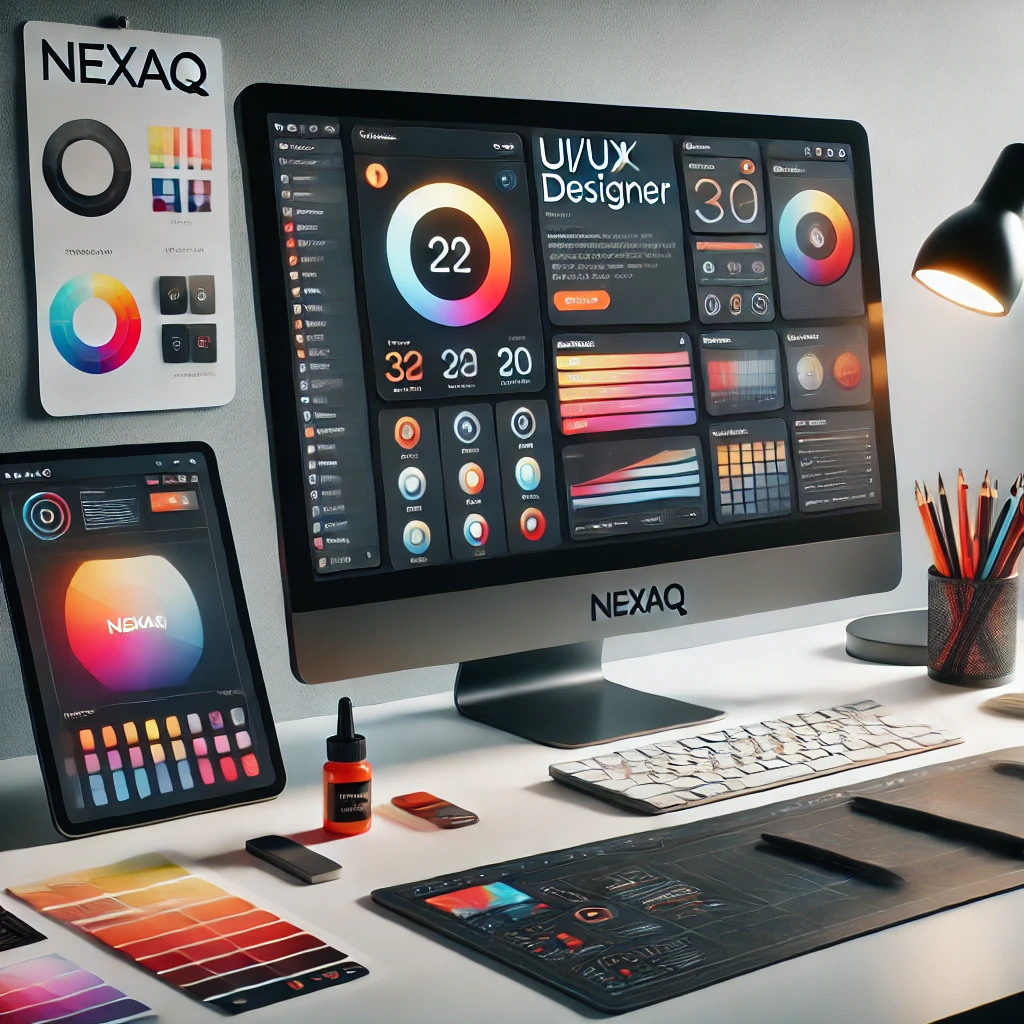Introduction
In today’s digital age, the demand for seamless, intuitive, and visually appealing interfaces has never been higher. Whether it’s a website, mobile app, or any digital product, the experience a user has while interacting with a platform is crucial for its success. NexaQ, a leading player in the tech industry, has recognized this need and has prioritized exceptional UI/UX design in all its digital offerings. At the heart of this transformation is the role of the UI/UX designer.
What is UI/UX Design?
Before diving into the role of a UI/UX designer at NexaQ, it’s essential to understand the distinction between UI (User Interface) and UX (User Experience) design. Although often used interchangeably, these two areas focus on different aspects of the design process:
- User Interface (UI) Design: This is the visual aspect of design. It deals with the look and feel of the product, including colors, typography, buttons, and icons. UI designers ensure that the interface is aesthetically pleasing and aligned with the brand’s identity.
- User Experience (UX) Design: UX design focuses on the overall experience a user has when interacting with a product. It’s about understanding the user’s journey, solving problems, and ensuring that the product is easy to use and functional. A UX designer maps out the user flow and ensures that each step in the process is efficient and enjoyable.
In the case of NexaQ, both UI and UX play critical roles in ensuring that their digital products are not only functional but also engaging and user-friendly.
The Role of a UI/UX Designer at NexaQ
At NexaQ, the UI/UX designer is not just a designer but a problem solver, communicator, and innovator. The designer’s role revolves around understanding the users’ needs and behaviors and then translating these insights into intuitive, user-friendly interfaces. Let’s explore the responsibilities and impact a NexaQ UI/UX designer holds within the organization.
1. User Research and Analysis
One of the primary responsibilities of a UI/UX designer at NexaQ is conducting user research. This involves gathering qualitative and quantitative data to understand users’ preferences, pain points, and behaviors. Techniques such as user interviews, surveys, and usability testing are often employed.
By analyzing this data, designers can gain insights into how users interact with NexaQ’s products, identifying opportunities for improvement and innovation. The aim is to create solutions that are not only functional but also delightful.
2. Wireframing and Prototyping
Once user research is completed, the next step is wireframing. A wireframe is a skeletal outline of a digital product, showcasing the basic layout and design elements. NexaQ UI/UX designers use wireframes to visualize the structure and flow of the interface without focusing on visual details.
After wireframes are approved, designers move on to creating interactive prototypes. These prototypes simulate the final product, allowing stakeholders and users to interact with the design before it is developed. At NexaQ, prototyping is a vital step that helps identify potential usability issues early in the design process, saving time and resources.
3. UI Design and Branding
While UX design focuses on functionality, UI design emphasizes aesthetics. A NexaQ UI/UX designer ensures that every element on the screen—buttons, icons, typography, colors—is carefully crafted to align with the brand’s visual identity. They pay close attention to detail, ensuring that each component is not only visually appealing but also contributes to a cohesive design system.
NexaQ places a strong emphasis on consistency in branding. The UI designer works closely with branding teams to ensure that the interface reflects the company’s values and personality. This consistency helps in building user trust and recognition across various platforms.
4. Usability Testing and Feedback Integration
No design is perfect from the start, which is why usability testing is an essential part of the design process at NexaQ. After creating prototypes, designers conduct user testing sessions to observe how real users interact with the product. This step helps in identifying any friction points or areas where users struggle.
Once the feedback is gathered, the UI/UX designer revisits the design and makes necessary improvements. At NexaQ, the iterative design process ensures that the final product is both user-centered and functionally robust.
5. Collaboration with Development Teams
UI/UX designers at NexaQ don’t work in isolation. Collaboration is key to delivering successful products. Designers frequently work alongside developers, project managers, and product owners to ensure that the final product matches the design specifications.
This close collaboration between design and development teams ensures that the final product not only looks good but also performs well across devices and platforms. Designers provide developers with design assets, specifications, and guidelines to ensure seamless implementation.
6. Continuous Learning and Adaptation
The tech industry is constantly evolving, and so is the field of UI/UX design. NexaQ understands the importance of staying ahead of trends and innovations in the design world. As a result, UI/UX designers at NexaQ are encouraged to continuously learn and adapt.
Whether it’s mastering new design tools, understanding emerging design trends, or keeping up with changing user behaviors, NexaQ’s design team is always on the cutting edge. The company fosters an environment where designers can experiment, learn, and grow professionally.
Why UI/UX Design is Critical for NexaQ’s Success
UI/UX design has a direct impact on user satisfaction, brand loyalty, and ultimately, business success. Here are a few reasons why UI/UX design plays such a vital role in NexaQ’s growth:
1. User Retention
A well-designed product that is easy to navigate encourages users to return. By focusing on delivering exceptional user experiences, NexaQ can retain more users, ensuring that they continue to engage with its products over time.
2. Brand Differentiation
In a competitive market, having a visually appealing and user-friendly product can set a company apart. NexaQ leverages UI/UX design as a differentiator, ensuring that its products stand out in terms of both aesthetics and functionality.
3. Increased Conversions
Good design directly impacts the bottom line. By streamlining the user journey and removing friction points, UI/UX designers help increase conversions, whether it’s making a purchase, signing up for a service, or completing any other desired action.
4. Enhanced Accessibility
NexaQ understands the importance of inclusivity. Its UI/UX designers ensure that all digital products are accessible to users with diverse needs, including those with disabilities. By adhering to accessibility standards, NexaQ not only reaches a broader audience but also demonstrates a commitment to social responsibility.
Tools and Technologies Used by NexaQ UI/UX Designers
UI/UX designers at NexaQ rely on a range of design tools and technologies to bring their ideas to life. Some of the most commonly used tools include:
- Figma: A collaborative design tool that allows for real-time collaboration between designers and developers.
- Sketch: A vector-based design tool often used for UI design.
- Adobe XD: A versatile tool for wireframing, prototyping, and creating interactive designs.
- InVision: A popular platform for prototyping and sharing designs with stakeholders.
- UsabilityHub: A platform for conducting usability tests and gathering user feedback.
These tools enable NexaQ’s UI/UX designers to work efficiently, ensuring that their designs are both innovative and practical.
Conclusion
The role of a UI/UX designer at NexaQ is multifaceted, blending creativity with analytical thinking. From understanding user needs to crafting visually stunning interfaces, NexaQ’s designers are at the forefront of innovation in the tech industry. Their work not only shapes the user experience but also drives the success of NexaQ’s digital products.
In an increasingly digital world, companies like NexaQ recognize the importance of investing in UI/UX design. By prioritizing user-centered design, they are not only enhancing the user experience but also building a loyal customer base that values both form and function.



